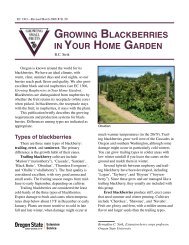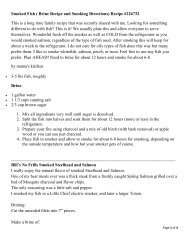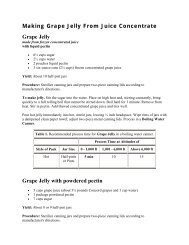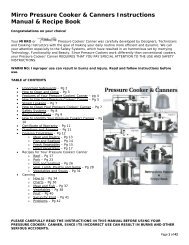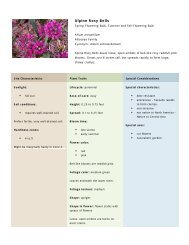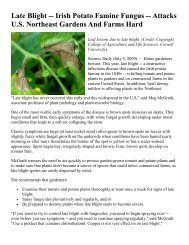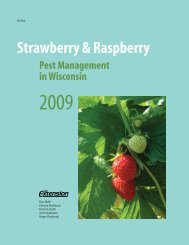Create successful ePaper yourself
Turn your PDF publications into a flip-book with our unique Google optimized e-Paper software.
BLUEBERRIES-Blueberries must be planted<br />
where they have full sun most of the day and<br />
in acidic soil (a pH of 4.5 to 5.5) that's well<br />
drained, porous and high in organic matter. The<br />
plants have shallow root systems and must be<br />
irrigated. A heavy mulch will help retain soil<br />
moisture and keep the roots cool. Prune half of<br />
the top growth and space plants 4-5 feet apart<br />
in rows 8-10 feet apart. Incorporate plenty<br />
of organic matter in and around the planting<br />
holes. Control weeds with mulch instead of<br />
cultivation.<br />
In cold climates, blueberries benefit from a thick layer of mulch during the winter. Prune<br />
for fewer but larger berries by removing old branches; fruit is produced on year-old wood.<br />
Before<br />
Pruning<br />
Pruning<br />
blueberries<br />
Cutout<br />
weak<br />
laterals<br />
Cut out<br />
heavy old stems<br />
Pruning Grapevines GRAPES--Grapes thrive in fertile, well-drained soil.<br />
Choose a site that offers protection from wind and late<br />
frost. If possible, run vines east-west to reduce shade<br />
cast by the trellis. Work in fair amounts of compost<br />
before planting but don't overfertilize. Set the plants 8<br />
After feet apart in rows 10 feet apart. For the first year, main<br />
Pruning stems should be allowed to grow unchecked, and vines<br />
~~_~~oWl~t2:15~~!B: should be trained on a trellis using two support wires.<br />
Prune in winter when dormant but before the weather<br />
becomes too cold. Canes that have borne fruit should be pruned back sharply (see illustration<br />
above). Remove old canes coming from the main stem and leave four new canes (shoots that<br />
started to grow the previous spring). The new canes should be cut back to 6 or 8 inches and<br />
have 3 or 4 buds. These buds, found at the joints, produce the new shoots that bear leaves<br />
and grapes the following summer. Four of these new shoots will be used to repeat the same<br />
fruiting-and-pruning process the following winter.<br />
RASPBERRIES-Raspberries are a bramble Pruning Red Raspberries<br />
fruit and should be cultivated as you would<br />
blackberries. Plants are more erect, but still<br />
benefit greatly from a simple trellis. Space red<br />
and yellow varieties 2 feet apart in rows 6 feet<br />
apart; blacks and purples 3 feet apart in rows 8 Pull<br />
feet apart. (NOTE: Plant blacks and reds 300 feet ~:~kers<br />
apart to prevent the spread of disease.) Except in<br />
the case of fall-bearing types, new canes don't<br />
produce fruit and put out few, if any, branches. Pruning Black Raspberries<br />
Little thinning is needed until plants have been<br />
in the ground for a few years.<br />
When thinning brambles, leave the thickest canes<br />
and remove the thinnest. Prune red and yellow<br />
raspberries back to 8-12 buds on a cane, leaving the<br />
thickest canes at least 4-6 inches apart in the spring.<br />
Remove the fruiting canes after harvest. Prune<br />
blacks and purples when new growth starts in the<br />
spring, leaving 10-15 buds per cane and 4-5 canes<br />
per clump. Encourage branching by pinching back the tips of black raspberry plants in late summer.<br />
With reds, remove suckers rather than canes from original plants (see illustration abovej.,<br />
PAGE 11




